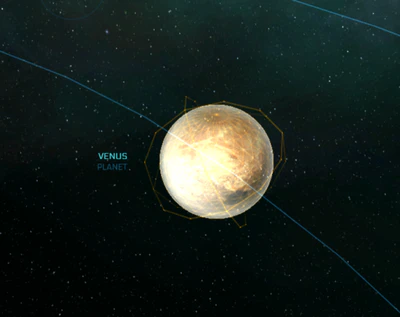Quick facts:Venus
Venus : Sol II
Orbiting the sun in the Sol system.
Sensors
Danger
1/10
Economy
1/10
Population
1/10
Atmospheric properties
Atmospheric pressure
90.804 Earths
Density
5.243 g/cm³
Physical characteristics
Equatorial radius
6,051.8 km (Real)
605.18 km (Ingame Scale)
605.18 km (Ingame Scale)
Sidereal rotation
-5,832.6 SEH (Retrograde)
Axial tilt
2.64° (For retrograde rotation)
Orbital parameters
Orbital period
224.701 SED
Orbital speed
35.02 km/s
Orbital radius
0.7233 AU (Real)
0.07233 AU (Ingame Scale)
0.07233 AU (Ingame Scale)
Orbital eccentricity
0.006772
Aphelion
0.7282 AU (Real)
0.07282 AU (Ingame Scale)
0.07282 AU (Ingame Scale)
Perihelion
0.7184 AU (Real)
0.07184 AU (Ingame Scale)
0.07184 AU (Ingame Scale)
Inclination
2.19°
Venus (Sol II) is the hottest planet in the Sol System, with an atmosphere is almost entirely composed of carbon dioxide.[1]
Humanity has made many failed attempts to terraform Venus. Instead of colonising the planets surface many permanent space stations orbit Venus.[2]
Atmospheric Composition
Venus has an incredibly thick (over 90 Earths), non-breathable carbon dioxide atmosphere with some nitrogen.
| Chemical Formula | Full Name | Amount |
|---|---|---|
| CO2 | Carbon Dioxide | 96.5% |
| N | Nitrogen | 3.5% |
| SO2 | Sulfur Dioxide | 0.015% |
| Ar | Argon | 0.007% |
| H2O | Water Vapour | 0.002% |
| CO | Carbon Monoxide | 0.0017% |
| He | Helium | 0.0012% |
| Ne | Neon | 0.0007% |
| COS | Carbonyl Sulfide | Trace |
| HCl | Hydrogen Chloride | Trace |
| HF | Hydrogen Fluoride | Trace |
See also
References
- ↑ Venus on ARK Starmap. Starmap
- ↑ Galactapedia: Venus (Sol II). Galactapedia. Retrieved 2024-09-30
Locations in the
Locations in the
Landing zones
Space stations
Stars
Moons
Jump points
